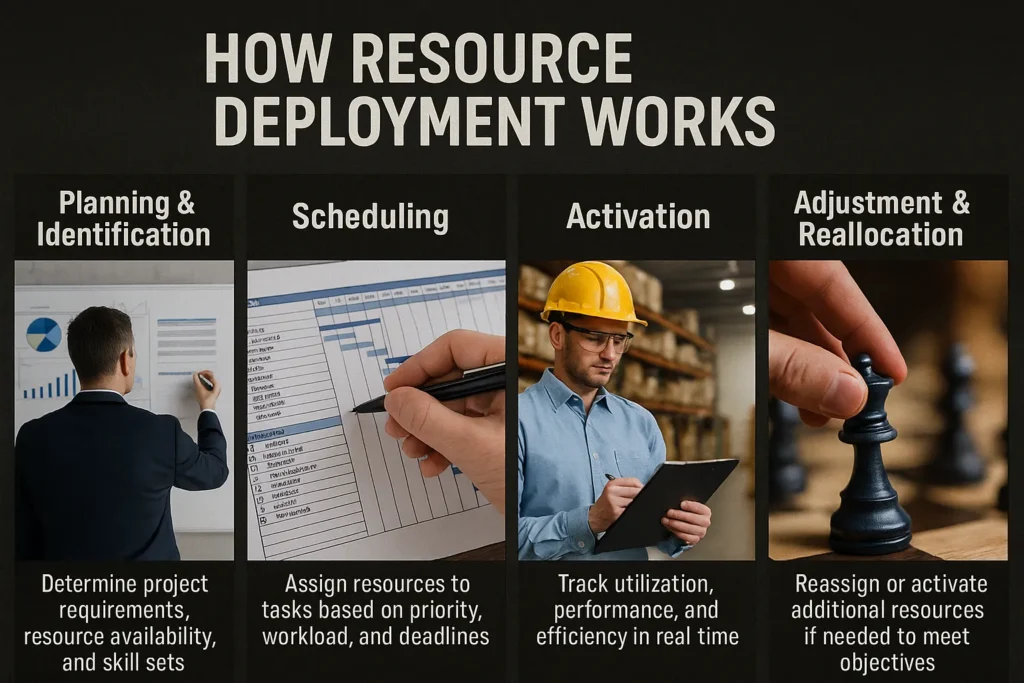
Executive Summary
Efficient resource management is crucial for organizations to achieve operational success, meet project deadlines, and optimize costs. A central aspect of resource management is deploying and activating personnel and resources. This task ensures that the right individuals, equipment, and materials are available at the right time to execute projects or operations effectively. Understanding this task, its purpose, and its best practices is vital for managers, team leaders, and operations professionals.
This guide explores the concept, the specific task responsible for deployment, its importance, processes, and strategic value to organizations.
Table of Content
Introduction
Resource management is the process of planning, allocating, and managing organizational assets—human, financial, and material—to achieve defined objectives efficiently. Among the many tasks involved, deploying or activating resources is the operational step where planning meets execution. Without proper deployment, even well-planned projects can fail due to idle resources, scheduling conflicts, or misallocation.
This tower page focuses on the task that handles this critical responsibility and how it fits into broader resource management practices.
Why Resource Deployment Is Critical
Resource deployment is make-or-break for operational and project success because:
- Ensures Operational Continuity: Personnel and resources must be available when needed to avoid delays.
- Optimizes Resource Utilization: Prevents underuse or overuse of resources, reducing cost waste.
- Supports Project Timelines: Proper activation aligns with project schedules for timely completion.
- Improves Accountability: Clearly defined assignments make monitoring and reporting easier.
- Enables Flexibility: Quick redeployment in response to changing priorities or emergencies.
The Task: Resource Allocation / Resource Deployment
The task responsible for deploying or activating personnel and resources is generally known as Resource Allocation or Resource Deployment.
Definition
Resource Allocation: The strategic assignment of available resources to tasks, projects, or departments based on priority, availability, and skill set.
Resource Deployment: The operational execution step where allocated resources are physically or digitally activated to perform their assigned tasks.
Key Objectives
- Assign the right personnel to tasks matching their skills.
- Deploy equipment, tools, and materials as required.
- Ensure timing aligns with project schedules.
- Monitor and adjust deployment as project needs evolve.
Understanding how allocation and deployment work together is only one piece of the puzzle.
To see how these concepts translate into coordinated field operations, explore What Is Resource Coordination in Incident Management: Definition, Role, and Benefits.
To learn how effective workforce scheduling and planning ensure proper deployment of people and assets, read What Is Workforce Management: Definition, Process, and Benefits Explained.
You can also see how larger initiatives maintain balance across multiple projects in The Ultimate Guide to Program Management: Processes, Tools, and Strategies.
How Resource Deployment Works
Resource deployment involves several steps that connect planning to execution:

- Planning & Identification: Determine project requirements, resource availability, and skill sets.
- Scheduling: Assign resources to tasks based on priority, workload, and deadlines.
- Activation: Mobilize personnel, tools, and materials to their designated tasks.
- Monitoring: Track utilization, performance, and efficiency in real-time.
- Adjustment & Reallocation: Reassign or activate additional resources if needed to meet objectives.
Types of Resources Deployed
Resource deployment is not limited to human personnel; it includes:
- Human Resources: Employees, contractors, consultants, or specialists.
- Equipment & Tools: Machinery, devices, software, or technical equipment.
- Financial Resources: Budget allocation and fund activation for project execution.
- Material Resources: Raw materials, consumables, or inventory items.
Benefits of Effective Resource Deployment
- Higher Productivity: Resources are used efficiently with minimal idle time.
- Reduced Costs: Avoids overstaffing or unnecessary equipment use.
- Improved Project Outcomes: Projects meet deadlines and quality standards.
- Employee Satisfaction: Clear assignments reduce confusion and stress.
- Enhanced Agility: Quick redeployment supports dynamic environments.
Best Practices
- Maintain a Centralized Resource Pool: Ensure all available resources are tracked and accessible.
- Use Resource Management Software: Tools can automate deployment and monitor utilization.
- Regularly Review Resource Plans: Adjust assignments based on progress and changing priorities.
- Prioritize Tasks: Align resources to high-impact or time-sensitive projects first.
- Communicate Clearly: Personnel must understand roles, responsibilities, and timelines.
Common Challenges
- Resource Conflicts: Multiple projects requiring the same resource simultaneously.
- Skill Mismatches: Personnel assigned without the right expertise.
- Underutilization: Idle resources due to poor planning or delayed activation.
- Overextension: Employees or equipment overloaded beyond capacity.
- Lack of Visibility: Inadequate tracking of resources reduces responsiveness.
Tools for Resource Deployment
Modern organizations often rely on resource management and project management software to manage deployment efficiently:
- Microsoft Project: Scheduling and allocation features.
- Smartsheet: Real-time tracking and activation dashboards.
- Asana & Trello: Task assignment with personnel visibility.
- SAP & Oracle ERP: Enterprise-level resource planning and deployment.
- Resource Guru / Float: Focused tools for workforce scheduling and activation.
Metrics to Measure Effectiveness
Organizations measure resource deployment effectiveness using metrics such as:
- Resource Utilization Rate: Percentage of available resources actively used.
- On-Time Task Completion: Tasks completed within planned timelines.
- Idle Time: Duration resources remain unassigned or inactive.
- Cost Efficiency: Cost of resource usage relative to output.
- Project Success Rate: Completion of projects on schedule and within budget.
Strategic Value
Proper resource deployment aligns with organizational strategy by:
- Maximizing ROI: Efficient use of personnel and resources enhances financial returns.
- Supporting Scalability: Enables handling multiple projects simultaneously.
- Reducing Risk: Mitigates delays and operational bottlenecks.
- Strengthening Competitiveness: Agile resource deployment responds faster to market or client needs.
Implementation Tips

- Start Small: Pilot resource deployment for a single team or project.
- Train Managers: Ensure managers understand allocation and activation principles.
- Integrate Systems: Link HR, operations, and project management tools.
- Continuously Monitor: Track performance and adjust in real-time.
- Document Procedures: Standard operating procedures reduce errors and confusion.
Case Example
Consider a software development company managing multiple projects:
- Planning: Team identifies available developers, testers, and servers.
- Allocation: Developers assigned to high-priority modules based on skill sets.
- Deployment: Personnel start working; servers and tools are activated.
- Monitoring: Project manager tracks task completion and resource usage.
- Adjustment: Resources are shifted to critical modules as deadlines approach.
This example demonstrates how resource deployment transforms planning into action.
Conclusion
The resource management task responsible for deploying or activating personnel and resources is Resource Allocation and Deployment. It is an essential bridge between planning and execution, ensuring that organizational assets are used effectively, projects stay on track, and business objectives are met. Organizations that master this task gain operational efficiency, improved project outcomes, and enhanced agility.
Key Takeaways
- Resource deployment ensures the right resources are available at the right time.
- Resource Allocation and Deployment involve planning, scheduling, activation, and monitoring.
- Effective deployment maximizes productivity, reduces costs, and supports organizational goals.
- Using proper tools and metrics enhances deployment effectiveness.
- Strategic resource management strengthens competitiveness and scalability.


